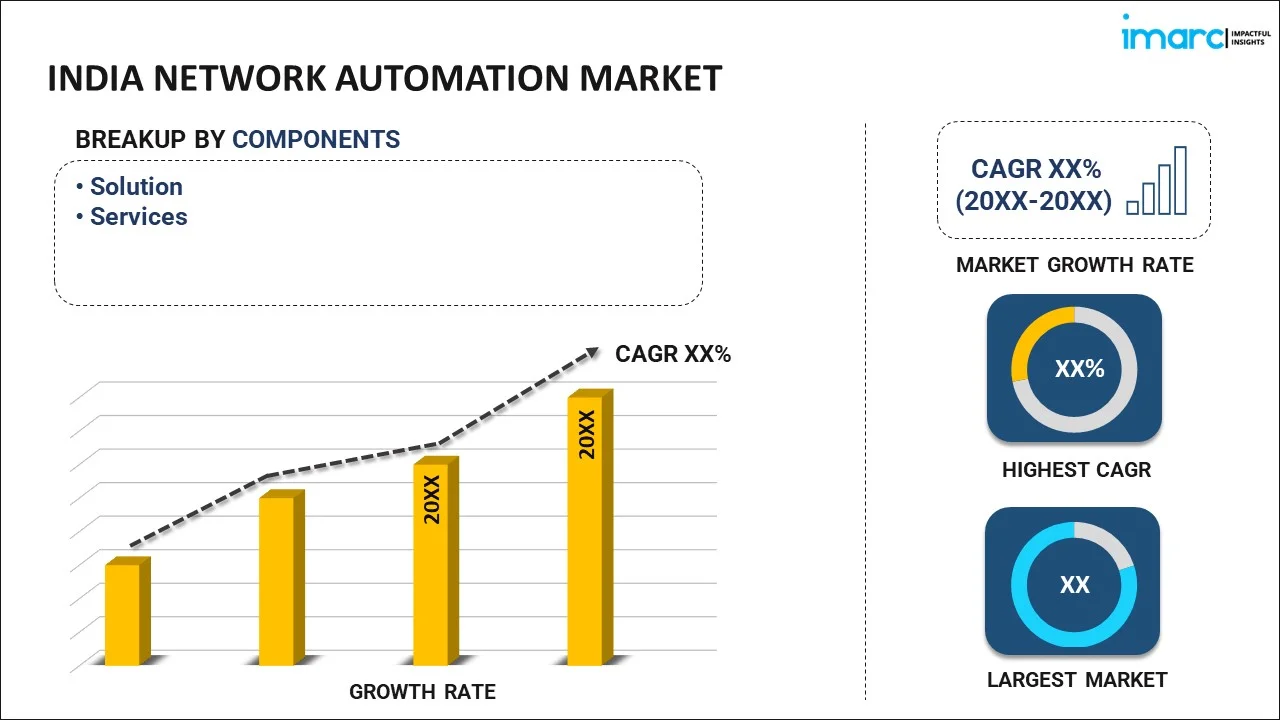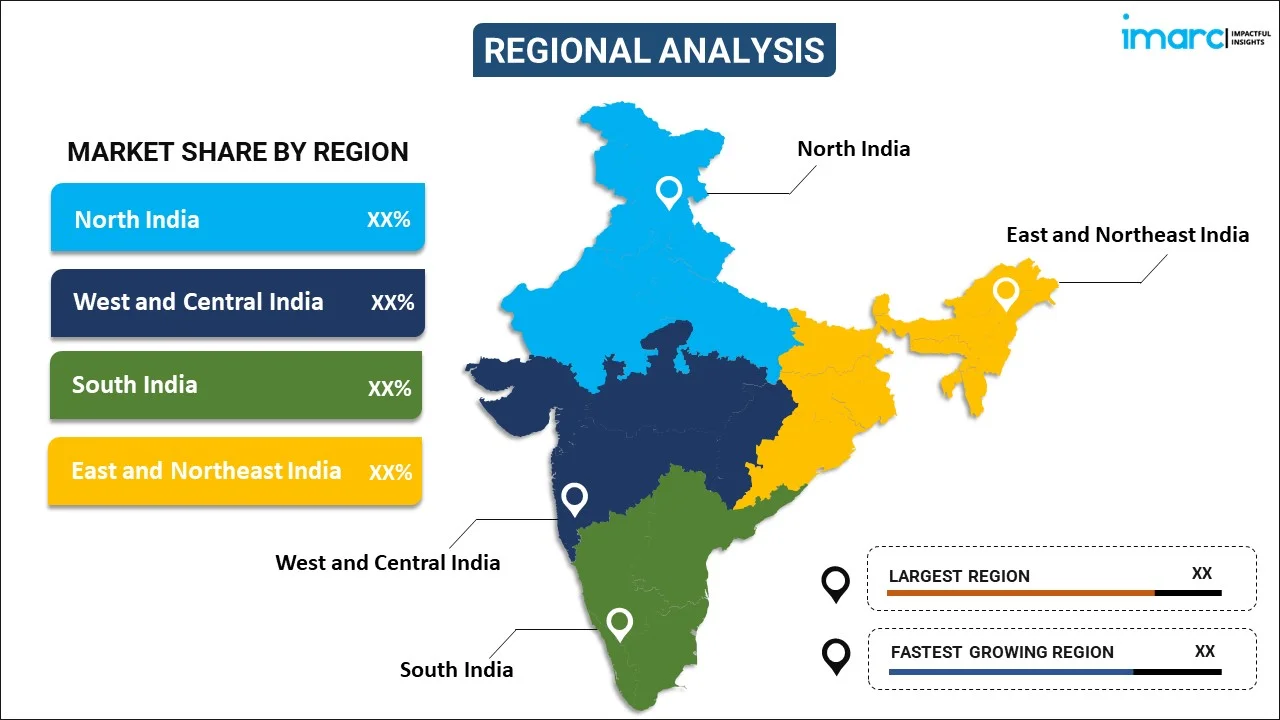IMARC made the whole process easy. Everyone I spoke with via email was polite, easy to deal with, kept their promises regarding delivery timelines and were solutions focused. From my first contact, I was grateful for the professionalism shown by the whole IMARC team. I recommend IMARC to all that need timely, affordable information and advice. My experience with IMARC was excellent and I can not fault it.
Read More
India Network Automation Market Report by Component (Solution, Services), Deployment Mode (On-premises, Cloud-based), Organization Size (Large Enterprises, Small and Medium-sized Enterprises), Network Type (Physical, Virtual, Hybrid), End Use Industry (IT and Telecom, Manufacturing, Energy and Utility, Banking and Financial Services, Education, and Others), and Region 2024-2032
Market Overview:
India network automation market size reached US$ 1.05 Billion in 2023. Looking forward, IMARC Group expects the market to reach US$ 6.49 Billion by 2032, exhibiting a growth rate (CAGR) of 21.70% during 2024-2032. The increasing demand for automation that can lead to cost savings by minimizing human errors, reducing downtime, and optimizing resource utilization, is driving the market.
|
Report Attribute
|
Key Statistics
|
|---|---|
|
Base Year
|
2023
|
|
Forecast Years
|
2024-2032
|
|
Historical Years
|
2018-2023
|
|
Market Size in 2023
|
US$ 1.05 Billion |
|
Market Forecast in 2032
|
US$ 6.49 Billion |
| Market Growth Rate 2024-2032 | 21.70% |
Network automation refers to the use of software and tools to perform network management tasks, configuration, and operation without manual intervention. It streamlines and accelerates repetitive processes, reducing the risk of errors and enhancing efficiency in managing complex networking environments. Automation encompasses tasks such as device provisioning, configuration changes, monitoring, and troubleshooting. By leveraging scripting, APIs, and orchestration, network automation enables rapid adaptation to dynamic network requirements and supports the implementation of consistent and standardized configurations. This not only improves the reliability and performance of networks but also frees up valuable human resources for more strategic, innovative, and complex network-related tasks. As organizations strive for agility and scalability, network automation becomes a crucial element in achieving a responsive and resilient infrastructure.
India Network Automation Market Trends:
The network automation market in India has emerged as a pivotal force in the ever-evolving landscape of information technology. To begin with, the relentless demand for enhanced operational efficiency is a key driver propelling the growth of the network automation market. Organizations are increasingly recognizing the need to streamline their network management processes, reduce manual intervention, and mitigate human errors. Moreover, the escalating complexity of network infrastructures necessitates a shift towards automation to ensure seamless operations. In addition to this, the advent of cutting-edge technologies like artificial intelligence and machine learning has significantly catalyzed the market momentum. As organizations strive to keep pace with the dynamic nature of digital transformation, these advanced technologies empower network automation solutions to adapt and optimize in real time. Furthermore, the rising volume of data traffic and the surge in the number of connected devices underscores the urgency for scalable and agile network management solutions. Consequently, enterprises are embracing network automation to not only cope with the increasing workload but also to enhance scalability and agility. Additionally, the imperative for rapid deployment of services and applications that fuels the demand for automated solutions, thereby enabling organizations to respond promptly to market demands, is expected to drive the regional market during the forecast period.
India Network Automation Market Segmentation:
IMARC Group provides an analysis of the key trends in each segment of the market, along with forecasts at the country level for 2024-2032. Our report has categorized the market based on component, deployment mode, organization size, network type, and end use industry.
Component Insights:

- Solution
- Network Automation Tools
- SD-WAN and Network
- Virtualization
- Internet-Based Networking
- Services
- Professional Service
- Managed Service
The report has provided a detailed breakup and analysis of the market based on the component. This includes solution (network automation tools, SD-WAN and network, virtualization, and internet-based networking) and services (professional service and managed service).
Deployment Mode Insights:
- On-premises
- Cloud-based
A detailed breakup and analysis of the market based on the deployment mode have also been provided in the report. This includes on-premises and cloud-based.
Organization Size Insights:
- Large Enterprises
- Small and Medium-sized Enterprises
The report has provided a detailed breakup and analysis of the market based on the organization size. This includes large enterprises and small and medium-sized enterprises.
Network Type Insights:
- Physical
- Virtual
- Hybrid
A detailed breakup and analysis of the market based on the network type have also been provided in the report. This includes physical, virtual, and hybrid.
End Use Industry Insights:
- IT and Telecom
- Manufacturing
- Energy and Utility
- Banking and Financial Services
- Education
- Others
The report has provided a detailed breakup and analysis of the market based on the end use industry. This includes IT and telecom, manufacturing, energy and utility, banking and financial services, education, and others.
Regional Insights:

- North India
- West and Central India
- South India
- East and Northeast India
The report has also provided a comprehensive analysis of all the major regional markets, which include North India, West and Central India, South India, and East and Northeast India.
Competitive Landscape:
The market research report has also provided a comprehensive analysis of the competitive landscape in the market. Competitive analysis such as market structure, key player positioning, top winning strategies, competitive dashboard, and company evaluation quadrant has been covered in the report. Also, detailed profiles of all major companies have been provided.
India Network Automation Market Report Coverage:
| Report Features | Details |
|---|---|
| Base Year of the Analysis | 2023 |
| Historical Period | 2018-2023 |
| Forecast Period | 2024-2032 |
| Units | US$ Billion |
| Scope of the Report | Exploration of Historical Trends and Market Outlook, Industry Catalysts and Challenges, Segment-Wise Historical and Future Market Assessment:
|
| Components Covered |
|
| Deployment Modes Covered | On-premises, Cloud-based |
| Organization Sizes Covered | Large Enterprises, Small and Medium-sized Enterprises |
| Network Types Covered | Physical, Virtual, Hybrid |
| End Use Industries Covered | IT and Telecom, Manufacturing, Energy and Utility, Banking and Financial Services, Education, Others |
| Regions Covered | North India, West and Central India, South India, East and Northeast India |
| Customization Scope | 10% Free Customization |
| Report Price and Purchase Option | Single User License: US$ 2699 Five User License: US$ 3699 Corporate License: US$ 4699 |
| Post-Sale Analyst Support | 10-12 Weeks |
| Delivery Format | PDF and Excel through Email (We can also provide the editable version of the report in PPT/Word format on special request) |
Key Questions Answered in This Report:
- How has the India network automation market performed so far and how will it perform in the coming years?
- What has been the impact of COVID-19 on the India network automation market?
- What is the breakup of the India network automation market on the basis of component?
- What is the breakup of the India network automation market on the basis of deployment mode?
- What is the breakup of the India network automation market on the basis of organization size?
- What is the breakup of the India network automation market on the basis of network type?
- What is the breakup of the India network automation market on the basis of end use industry?
- What are the various stages in the value chain of the India network automation market?
- What are the key driving factors and challenges in the India network automation?
- What is the structure of the India network automation market and who are the key players?
- What is the degree of competition in the India network automation market?
Key Benefits for Stakeholders:
- IMARC’s industry report offers a comprehensive quantitative analysis of various market segments, historical and current market trends, market forecasts, and dynamics of the India network automation market from 2018-2032.
- The research report provides the latest information on the market drivers, challenges, and opportunities in the India network automation market.
- Porter's five forces analysis assist stakeholders in assessing the impact of new entrants, competitive rivalry, supplier power, buyer power, and the threat of substitution. It helps stakeholders to analyze the level of competition within the India network automation industry and its attractiveness.
- Competitive landscape allows stakeholders to understand their competitive environment and provides an insight into the current positions of key players in the market.
Need more help?
- Speak to our experienced analysts for insights on the current market scenarios.
- Include additional segments and countries to customize the report as per your requirement.
- Gain an unparalleled competitive advantage in your domain by understanding how to utilize the report and positively impacting your operations and revenue.
- For further assistance, please connect with our analysts.

Purchase Options
Benefits of Customization
Personalize this research
Triangulate with your data
Get data as per your format and definition
Gain a deeper dive into a specific application, geography, customer, or competitor
Any level of personalization
Get in Touch With Us
UNITED STATES
Phone: +1-631-791-1145
INDIA
Phone: +91-120-433-0800
UNITED KINGDOM
Phone: +44-753-714-6104
Email: sales@imarcgroup.com
 Inquire Before Buying
Inquire Before Buying Speak to an Analyst
Speak to an Analyst  Request Brochure
Request Brochure  Request Customization
Request Customization



.webp)




.webp)












